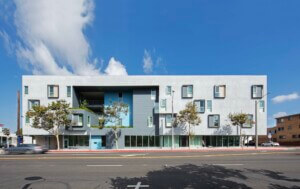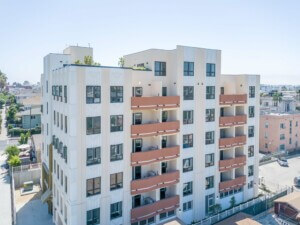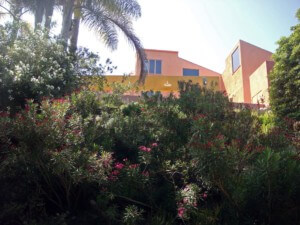The fabrication team cut, folded, and welded 264 aluminum panels into 66 uniquely shaped sun shades.
One of the challenges of designing affordable housing, points out Kevin Daly, principal at LA firm Daly Genik Architects, is “managing a balance between the economic forces that demand repeatability and the risk that monotony comes with that repetitiveness.”
Daly Genik and LA fabricators Machineous came up with a great solution for Broadway Apartments, an affordable project at the corner of Broadway and 26th Street in Santa Monica, developed by Community Corporation of Santa Monica.
- Fabricator Machineous
- Architect Daly Genik
- Location Santa Monica
- Date of Completion August 2012
- Material Marine Grade 5052 Aluminum Sheet, Urethane Paint
- Process Rhino, Excel, 3D Surveying, CNC Cutting, Aluminum Welding
The project is made up of four nearly identical building blocks, arranged in a pinwheel plan around the site. Each has a facade primarily facing the sun, so to allow for large windows on these flanks the firm chose to install large, angular aluminum shades, projecting around the windows. The shades also animate the facades, forming a 3-dimensional tapestry along the building’s edge.
To provide the efficiency that Daly describes, the shades are all made using the same material—1/4 inch thick aluminum, coated with urethane paint—and the same technique—CNC milling. But in order to avoid the monotony that Daly also refers to, each one of the shades’ 264 aluminum panels are slightly different in size and shape. The 66 hoods range in size from 48 inches by 72 inches to 120 inches by 72 inches. The walls containing the hoods are also slightly curved, creating even more variety.
Machineous cut each panel using its massive in-house robotic CNC mills, which have six-axis arms that can work in three dimensions. The mills were originally designed to produce cars in assembly plants. Each shade was “unfolded” into four parts from the Rhino documents and the 3D surveying data (to make sure the shades met the curving walls plum) that Daly Genik provided, post-scripted in Excel, and “nested,” as Machineous principal Andreas Froech puts it, onto 48-inch-by-144-inch aluminum sheets.
Each of the shades’ four pieces were continuously welded at the corners to produce a continuous look. Machineous had to make several mockups to try out this technique. A stiffening 2-inch-wide bar of the same material was folded down along the horizontal front edges to avoid any sagging of the up to 120-inch span of the shades.
The shades’ immense variety required careful communication. Each sheet had to be labeled with a sharpie after being cut out to keep track of it all since they weren’t built according to location. “Every part is one of a kind and cannot be replaced by another one,” said Froech. “That’s always the challenge of designing with multiples and variation. It’s a little nerve wracking. It’s a huge puzzle.” But the puzzle worked, mostly on the first try. “It’s so complex, but also simple,” said Froech. “It’s really just cutting out shapes. But there’s no room for error. If something’s not right it gets complicated very quickly. What you see is what you get.”










